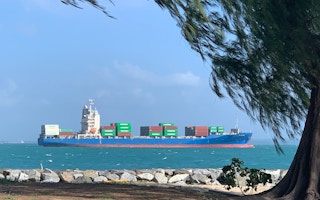Shipping is one of the toughest industries to decarbonise with efforts complicated by the difficulty to accurately measure the emissions of vessels.
To continue reading, subscribe to Eco‑Business.
There's something for everyone. We offer a range of subscription plans.
- Access our stories and receive our Insights Weekly newsletter with the free EB Member plan.
- Unlock unlimited access to our content and archive with EB Circle.
- Publish your content with EB Premium.
To get a clearer picture of the emissions of ships, eight of the world’s biggest shipping and supply chain firms are installing carbon measurement hardware onboard vessels and at ports, it was announced on Thursday.
Maritime emissions are typically measured using mathematical models or visual analysis of exhaust stack smoke. The use of online carbon calculators have produced a range of different results depending on the technology used, which makes tracking the decarbonisation of the sector unreliable. The cost of hardware, high temperatures in exhaust stacks and harsh weather conditions have further stalled efforts to install carbon measurement technology.
Developed by French startup Everimpact, the technology uses sensors to measure carbon emissions in real-time. It has been applied to urban settings and refineries until now but this is the first time it will be deployed on ships.
The engineering part of the deal is being led by Norwegian marine services firm Wilhelmsen and Japanese chemicals company Mitsubishi Corporation. Investors include Motion Ventures, Asian Development Bank’s venture arm, ADB Ventures, and IMC Ventures, which collectively aim to raise US$1.6 million in seed funding to develop the technology.
Ships in Singapore owned by Mitsubishi Corporation will take part in a trial to validate the system.
Mathieu Carlier, founder and chief executive of Everimpact, said the deal marked a step towards solving “one of the shipping’s most overdue challenges” — accurately measuring the carbon exposure of an industry responsible for transporting 80 per cent of the world’s trade.
From his experience measuring emissions in smart cities and in other industries, using sensors could improve the accuracy of measurement by around 20 per cent, compared to other methods, Carlier said.
Shipping emissions are projected to grow from 3 per cent today to 17 per cent of all man-made carbon pollution by 2050, at the current rate of industry growth.
The International Maritime Organisation, the trade body for the shipping industry, has set a target to reduce the industry’s greenhouse-gas emissions by at least 50 per cent by 2050, and to reduce the carbon intensity of emissions by 40 per cent by 2030 and 70 per cent by 2050, compared to 2008 levels, by switching to low-carbon fuels and using electricity from renewable resources.
The cost of meeting these targets has been highlighted as a key obstacle to decarbonisation, estimated at US$1.65 trillion by 2050. Measuring carbon is costly too. But Carlier said his firm was working on reducing the cost of his measurement technology by about 50 per cent.
“When we started our company in 2015, we had to explain climate risk to industries, and why it was important to measure carbon. But in the last two years, we’ve finally started to see recognition of the need to measure carbon,” he said.
“In the shipping trade, we’ve seen some progress on climate, but decarbonisation will take time and investment. Measurement is a way to mobilise capital and accelerate the energy transition,” said Carlier.
Carlier said that penetrating the shipping market and scaling his technology is not easy, but he is looking to partner with sustainability-focused early adopters with ambitions to reduce their carbon footprint.










